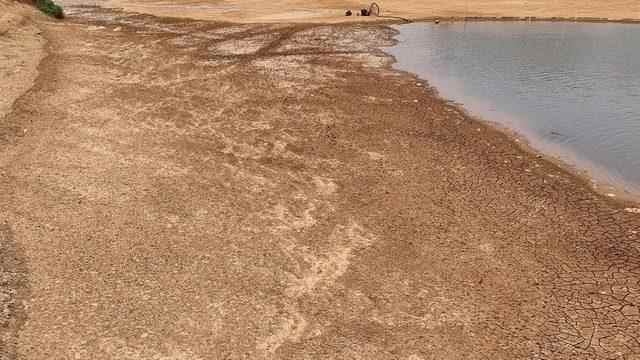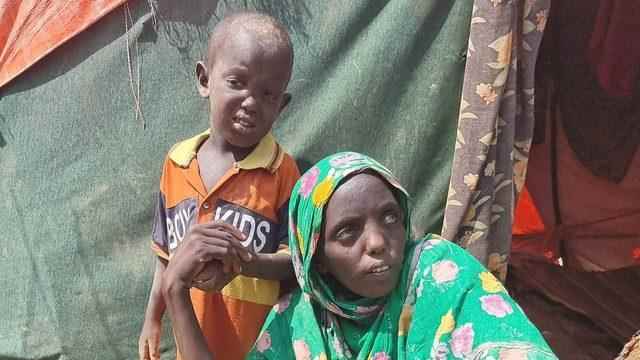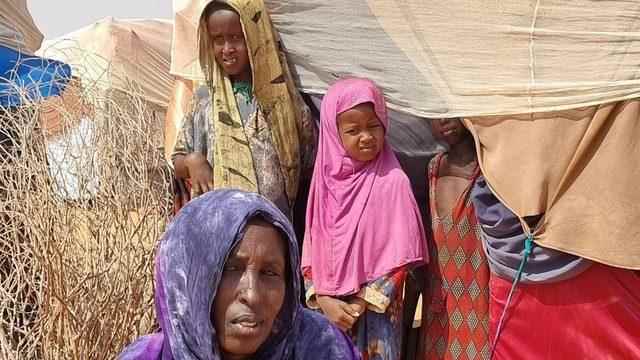More and more parents in Somalia find it difficult to find food and water for their children. Many families apply to malnutrition treatment centers established in various regions of the country.
Nimco Abdi’s 6-month-old daughter, who came to a treatment center in the town of Luuq, 500 kilometers west of the capital Mogadishu, is much smaller than she should be, and weighs only 4 kilograms.
Nimco explains that his daughter has become weak due to not being fed properly, showing that her eyes are sunken, her bones are prominent, and her skin is wrinkled and pale.
When Nimco takes him in his arms, the sound he makes is almost inaudible.
“I used to breastfeed, but I got very sick because I couldn’t feed myself. My daughter became so weak that I decided to bring her here. At least there is medicine and milk,” says Nimco.
There are many mothers in Somalia, like Nimco, who are about to lose their children to starvation.
“If nothing is done, 350,000 of the 1.4 million starving children in the country will die,” says Adam Abdelmoula of the United Nations Humanitarian Coordination Office.
Abdelmoula explains that some young girls in Somalia were married off at an early age because their families could no longer care for them.
Abdelmoula says, “Forty schools were closed due to the drought in the Jubaland region in Southern Somalia. We expect similar situations to occur in other drought-affected regions of the country. Currently, 70 percent of children in Somalia cannot go to school.”
VILLAGES ARE Abandoned
Drought in Somalia, which covers almost 90 percent of the country, is thought to have affected the lives of 4.5 million people.
It is noted that the largest river, the Juba River, is almost completely dry.
Fatuma Mohamed, who works as a nurse at the treatment center in the town of Luuq, explains that there are more than 50 families in the 18-person center and the beds are overflowing.
“We’re too full, we’re working way beyond our capacity. We can’t find enough medicine for everyone anymore,” says Mohamed.
Mohamed explains that children with watery diarrhea and measles come to the center due to nutritional deficiencies, while some children die before reaching the centre.
The United Nations (UN) states that approximately 700 thousand people have to leave their places of residence to find water and food for themselves and their animals, and this number is increasing every day.
Villages and towns are being abandoned in rural areas.
Villagers are beginning to migrate to the cities due to rapidly increasing water and food prices.
Many people set out with their animals, which are their source of income under normal circumstances, but many of the animals die on the way.
In villages, the elderly, unable to move, wait for the rain or hope that the young will bring water.

The drought is affecting not only Somalia, but the entire Horn of Africa and many parts of the rest of the continent.
The International Committee of the Red Cross (ICRC) reports that about 25 percent of people in Africa are experiencing a food security crisis.
Experts say that the crisis was overshadowed by the Russia-Ukraine war, all support was directed to Ukraine and Africans were forgotten.
THE WORST IS NOT YET
Humanitarian organizations working in Africa state that support activities in the region have been affected by a very serious financial crisis and that they can only reach 3 percent of the required budget.
Drought is causing many families to be split. While men are looking for work in urban areas, women and children are heading to areas where there is assistance.
But there are concerns that the worst is yet to come, as April showers are expected to be below average.

Hawa Fargod, 7 months pregnant, lives with her two young children in a camp in the Galkayo district, hundreds of kilometers north of Luuq. Everyone in the camp lives in tents made of bushes and old clothes.
Hawa is battling kidney disease and her children are sick too.
Humanitarian organizations continue to work to send aid to these areas, but say they will not be able to continue in the coming weeks if they do not receive sufficient financial support.
Stating that she has no hope for the future of herself and her children, Hawa says, “I am very afraid for my children.”
